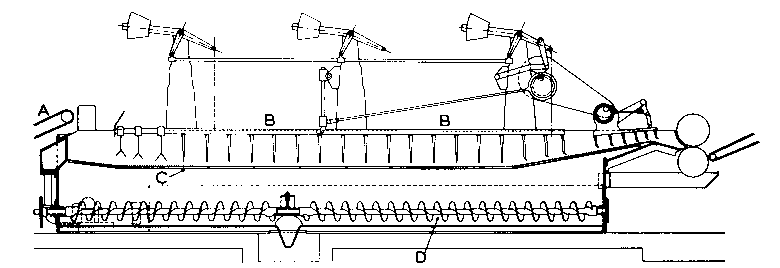Table of Contents
Chapter 5
I 1788 - State Of The Art In Textile Technology
II Australian Textiles - The Early Days
III Australian Textiles - The 20th Century
i Technology and Development
ii Australian Wool Textile Research
IV Australian Textiles - To Date
V Acknowledgements
References
Index
Search
Help
Contact us

|
13 A typical scouring bowl of the 1950s. The machine normally comprised four or five cast iron bowls, fitted with perforated false bottoms and separated squeeze rollers. After the machine has been filled with the scouring liquor and raised to the appropriate temperature the wool is fed into the first compartment on a short brattice A. It is conveyed over a false bottom by the reciprocating movement of a harrow B. the forks attached to the harrow move as a group and are operated by a combination of cams and cranks so that the wool is advanced about one foot during each forward movement. The forks are then lifted out to move backwards to the original position ready to repeat the cycle. the solid dirt is detached in the first bowl and falls through the perforations in the false bottom C into a trough from which it is continuously removed. There is a channel at the base in which a shaft D fitted with spiral fins rotates, bringing the sludge to a central point where it can be discharged automatically through outlet valves. The liquor removed from the first bowl is replenished by a counterflow system.

[Return to Text]
© 1988 Print Edition pages 277 - 278, Online Edition 2000
Published by Australian Science and Technology Heritage Centre, using the Web Academic Resource Publisher
http://www.austehc.unimelb.edu.au/tia/286_image.html
|






